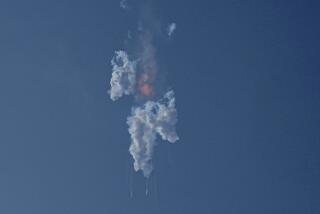New idea for space travel?
- Share via
Since Robert Goddard launched a 10-foot rocket from a New England farm more than 80 years ago, the basic principles of space travel haven’t changed much. Still required: a violent combustion of fuel and oxygen to propel the vehicle.
Unless, maybe, you have a laser and a couple of mirrors.
Young K. Bae, a maverick one-man rocket research institution in Tustin, believes he has hit on a propulsion technology that could revolutionize space travel, finally overcoming the limits of chemical rockets, which are slow and dangerous and need vast amounts of fuel.
The 51-year-old physicist calls it the photonic laser thruster.
“This overcomes the physical barriers of current rocket technology,” he says, pointing to a tiny laser encased in glass at the Bae Institute. “This is the tip of the iceberg.”
Hurling ships into space with light beams has been the stuff of science fiction novels for decades, but Bae says he has proved that it really is just science. He says a laser beam bouncing off two mirrors facing each other was able to exert force on one of the mirrors, albeit ever so slight.
The discovery came in December, but Bae waited months to reveal the experiment to verify that the measuring devices were accurate and that the results could be repeated.
It was a tiny step but monumental, because no one had done it before. Franklin B. Mead, a rocket propulsion expert at the Air Force Research Laboratory, calls it “pretty incredible.”
The photonic laser thruster can in theory be made much more powerful -- strong enough to propel a spacecraft to near light speed.
“If it proves out it would be revolutionary,” says Carl Ehrlich, a retired aerospace engineer who has worked on the space shuttle and other rocket programs.
Bae says he is developing the technology in tiny, incremental steps. Within a year or two, he will attempt to have the laser device lift an object the size and weight of a compact disc.
Ehrlich will be watching.
“We’re still using the same technology developed by Goddard. We need a breakthrough,” he says.
On the other hand, he cautions that Bae’s technology is “so far out there” that it’s hard to gauge its merit or significance.
“He may have a pony in there,” Ehrlich says, referring to the possibility of a major discovery, “but I’m not sure if anyone is qualified to say.”
Bae has the credentials to prove his point. An immigrant from South Korea, he earned his doctorate in atomic and nuclear physics at UC Berkeley before working at some of the nation’s top research labs on some of the most advanced projects, including missile defense, antimatter technology and nuclear fusion propulsion.
One of his mentors was Raymond Davis Jr., a Nobel Prize-winning physicist with whom Bae worked at Brookhaven National Laboratory, a federally funded research center on New York’s Long Island.
In 2002, Bae says, he realized he needed to strike out on his own to chase his dream, a concept first envisioned by Albert Einstein. He established his institute, setting up shop in a building housing doctors and lawyers in the Old Town section of Tustin. His office neighbors were perplexed.
“When I talked about photonic rockets,” he recalls, “they thought it was science fiction.”
His feelings weren’t hurt.
“For most people, the magnitude of the ramifications is hard to grasp,” he says. “The problem is that it’s an extremely new idea. It took 10 years for me to fully grasp it, so I think it’ll take a long time for people to understand it.”
To make ends meet, Bae worked for a while as a consultant for defense and aerospace firms, doing his research at night and on weekends.
Then early last year he won a $75,000 grant from NASA, which in the fall gave Bae a second grant of $220,000. That grant money is about to run out.
Now he is in talks with several companies, including defense contractor Northrop Grumman Corp., about a collaboration. Other federal agencies including the Air Force are considering funding some aspects of his research. Bae isn’t sure how much money would be needed because it could take decades to develop a laser thruster powerful enough to propel a manned spacecraft.
But he is patient. Already, he says, “it’s been a 25-year pursuit.”
And he knows he wouldn’t be the first scientist to be scorned for having a crazy idea.
In an infamous editorial, the New York Times in 1920 mocked Goddard and the possibility of using rockets to reach the moon, saying Goddard “only seems to lack the knowledge ladled out daily in high schools.”
On July 17, 1969, the day after the launch of Apollo 11, the newspaper published a correction: “It is now definitely established that a rocket can function in a vacuum as well as in an atmosphere. The Times regrets the error.”
--
(BEGIN TEXT OF INFOBOX)
Rocket scientist
Who: Young K. Bae
Age: 51
Education: Bachelor’s in physics from Seoul National University, skipped master’s program and earned a doctorate in atomic and nuclear physics at UC Berkeley
Family: Married to Gilda Jani and has a 5-year-old daughter, Jasmine
Hobbies: Playing guitar and piano
Favorite book: Lao Tzu’s Book of Virtues
Best time for coming up with ideas: While driving
Reasons for working alone: No distractions, freedom to “think out of the box”






